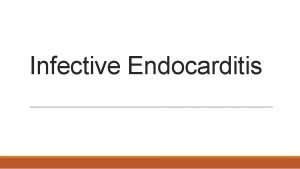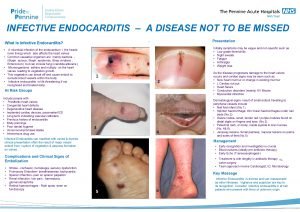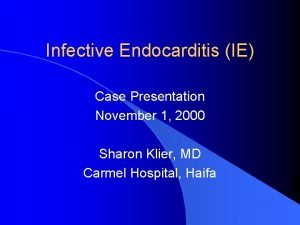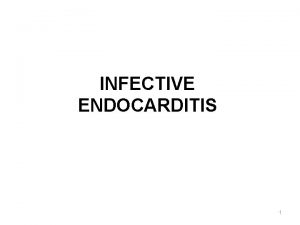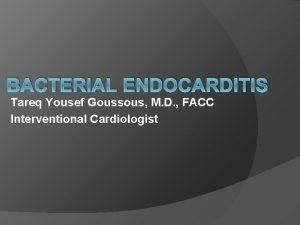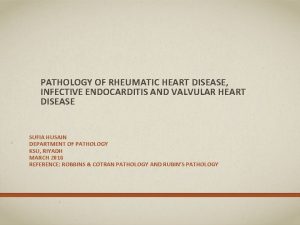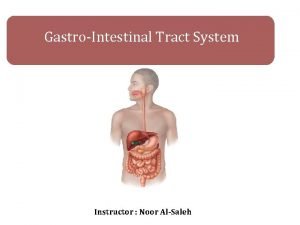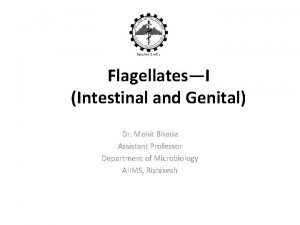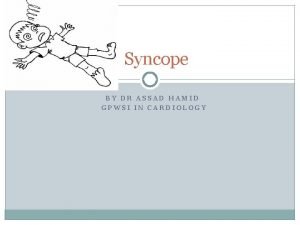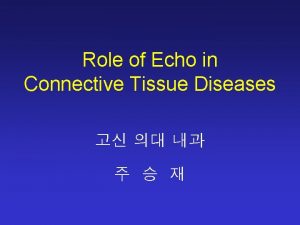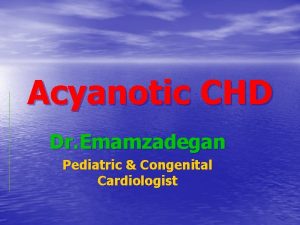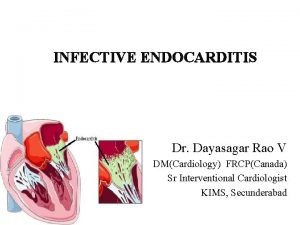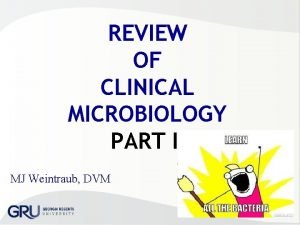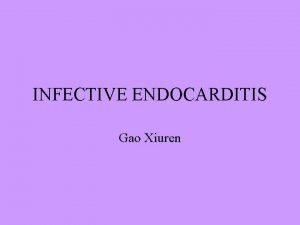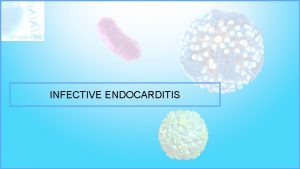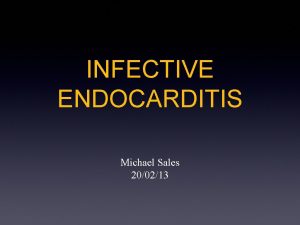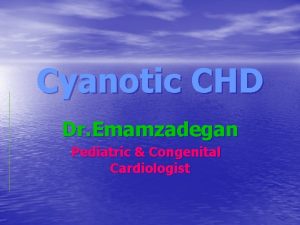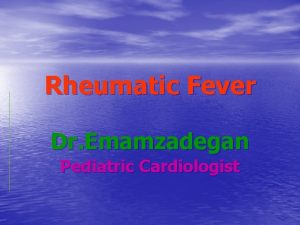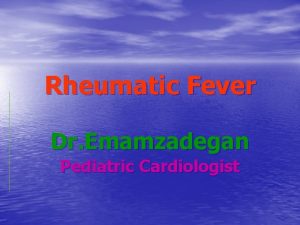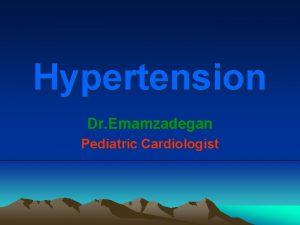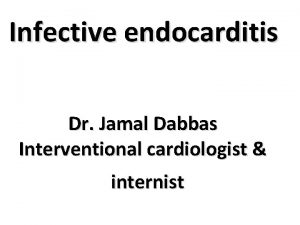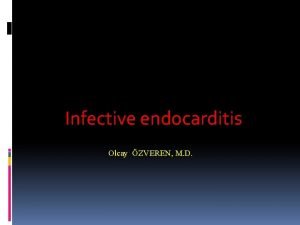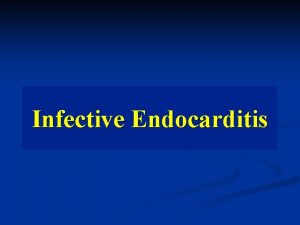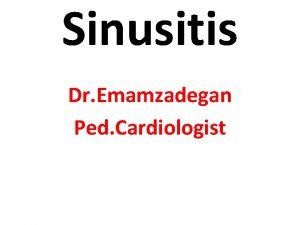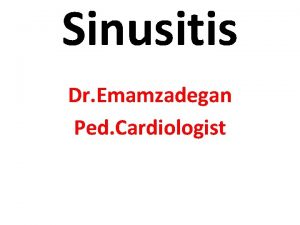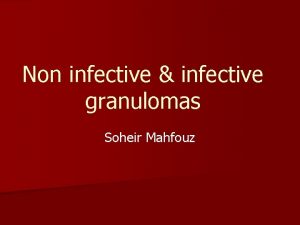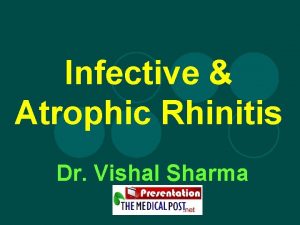Infective Endocarditis Dr Emamzadegan Pediatric cardiologist ETl 0


















- Slides: 18

Infective Endocarditis Dr. Emamzadegan Pediatric cardiologist

ETl 0 L 0 GY Viridans-type streptococci( α, hemolytic streptococci)and Staphylococcus aureus are the leading causative agents for endocarditis in pediatric patients.

ETl 0 L 0 GY Staphylococcal endocarditis is more common in patients with no underlying heart disease.

ETl 0 L 0 GY Viridans group streptococcal infection is more common after dental procedures;

ETl 0 L 0 GY Group D enterococci are seen more often after lower bowel or genitourinary manipulation; Pseudomonas aeruginosa or Serratia marcescens is seen more frequently in intravenous drug users; fungal organisms are encountered after open heart surgery.

ETl 0 L 0 GY Coagulase-negative staphylococci are common in the presence of an indwelling central venous catheter.

EPIDEMI 0 L 0 GY Infective endocarditis is often a complication of congenital or rheumatic heart disease but can also occur in children without any abnormal valves or cardiac malformations.

EPIDEMI 0 L 0 GY Endocarditis is rare in infancy; in this age group, it usually follows open heart surgery or is associated with a central venous line.

EPIDEMI 0 L 0 GY Children with ventricular septal defects (VSDs), left-sided valvular disease such as aortic stenosis, tetralogy of Fallot, and patent ductus arteriosus are at highest risk.

EPIDEMI 0 L 0 GY Children who have undergone valve replacement or valved conduit repair are also at high risk.

EPIDEMI 0 L 0 GY In 30% of patients with infective endocarditis, a predisposing factor is recognized. A surgical or dental procedure can be Implicated in 65% of cases in which the potential source of bacteremia is identified. Poor dental hygiene in children with cyanotic heart disease results in a greater risk for endocarditis

CLINICAL MANIFESTATI 0 N P: 1954

Diagnosis The Duke criteria help in the diagnosis of endocarditis. Major criteria include (1) positive blood cultures (two separate cultures for a usual pathogen) (2) evidence of endocarditis on echocardiography racardiac mass on a valve or other site, gurgitant flow near a prosthesis , abscess, tial dehiscence of prosthetic valves, or new valve regurgitant flow).

PR 0 GN 0 SIS AND C 0 MPLICATIONS Despite the use of antibiotic agents, mortality remains at 20 -25%. Serious morbidity occurs in 50 -60% of children with documented infective endocarditis. ( the most common is heart failure caused by vegetations involving the aortic or mitral valve. )

C 0 MPLICATIONS Myocardial abscesses and toxic myocarditis; arrhythmias; Systemic emboli; mycotic aneurysms, rupture of a sinus of Valsalva, obstruction of a valve secondary to large vegetations, acquired VSD, and heart block as a result of involvement (abscess) of the conduction system; meningitis, osteomyelitis, arthritis, renal abscess, and immune complex-mediated glomerulonephritis.

TREATMENT Antibiotic therapy should be instituted immediately once a definitive diagnosis is made. avoided. A total of 4 -6 wk of treatment is recommended.

PREVENTION 1. Proper general dental care and oral hygiene are most important in decreasing the risk of infective endocarditis in susceptible individuals. 2. Vigorous treatment of sepsis and local infections and careful asepsis during heart surgery and catheterization reduce the incidence of infective endocarditis.

PREVENTION P: 1960, 1961
 Infective endocarditis
Infective endocarditis Signs of infective endocarditis
Signs of infective endocarditis Dukes criteria
Dukes criteria Endocarditis
Endocarditis From jane mnemonic endocarditis
From jane mnemonic endocarditis Infective endocarditis
Infective endocarditis Dukes criteria for infective endocarditis
Dukes criteria for infective endocarditis Aschoff bodies
Aschoff bodies Termatoda
Termatoda Filariasis infective stage
Filariasis infective stage Helminths classification
Helminths classification Non-infective
Non-infective Balantidium coli infective stage
Balantidium coli infective stage Trichomonas vaginalis infective stage
Trichomonas vaginalis infective stage Gpwsi cardiology
Gpwsi cardiology Libman sacks endocarditis echo
Libman sacks endocarditis echo Complete endocardial cushion defect
Complete endocardial cushion defect Dr. dayasagar rao v
Dr. dayasagar rao v Tsia
Tsia
